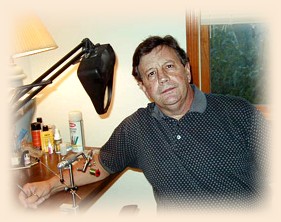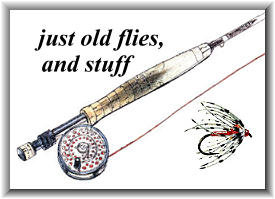This fly was developed for Kamloops rainbow trout by
Canada's legendary Bill Nation. He fished and guided
many lakes in the area, but Paul Lake was his home,
in the heart of the Kamloops region of British
Columbia. The green sedge was originally not found
in Paul Lake, but Bill Nation changed that in the
late '20s. He talks of the introduction of the sedge
to Paul Lake in a letter to Roderick Haig-Brown from
1938:
"Paul is much same, fish in hard silvery condition,
and very fat. They will be larger this year than
last, as the feed in the lake is on the increase.
The lake has been very high for three years, and
this has increased the shallow water breeding area
of the aquatic insects, and protected the gravid
female shrimps from fish and ducks. The green sedge
that I introduced in the nymph stage from Knouff to
Paul in 1925, 26 and 27 had increased to such numbers
by 1928 that is became the principal sedge on the lake,
and this is very gratifying, as this sedge was unknown
on Paul before the stocking."
To say that Bill Nation had his finger on the pulse
of Paul Lake would be an understatement. Bruce
Hutchinson in his book on the Fraser had this to
say regarding this quintessential guide:
"The Kamloops country was long the undisputed kingdom of
Bill Nation. That extraordinary man, who knew trout better
than any other British Columbian and had spent his life
studying the insect life on which trout feed, chose to
call himself a guide. Careless of fame or money, he would
row you around Paul Lake, his favourite(sic), or any other
lake you fancied for a few dollars a day. After an hour's
fishing with him the richest American tycoon was subdued
and humble in this shy man's presence. Beside his life of
innocence and content, the perfect companionship of man
and nature, your own life suddenly appeared for the failure
it was. And what could you say for your skill when he could
cast a fly and pierce the tail of any fish you pointed out
among the autumn salmon horde?..."
Perhaps the most astounding information I ran across in
my reading about the glory days of the Kamloops region
of B.C. was that pertaining to the numbers of fish, and
their size. Knouff Lake was considered "ruined" when
overstocking resulted in fish of only a pound and a half.
The average trout was four pounds, and went as large as
fifteen pounds. Bill Nation would guarantee a customer
one hundred fish a week. According to a web site I just
looked at, the rainbows there still go three and a half
pounds to this day. Amazing.
This fly was fished as a nymph, and Bill Nation gives us
some insight into how to fish it:
"Note that the nymph of the green sedge moves in a series
of tiny jerks; these seem to be of great intensity, but
each fierce, convulsive jerk only manages to move the
nymph forward less than an eighth of an inch. This nymph
moves on the shoals each evening from 10 o'clock on for a
few days before hatching, and are in the chara weed, and
the dyed seal's fur body of the sedge fly imitates the case
more nearly than it does the actual body of the nymph. The
fly is fished quite slowly under these conditions, and a
very short, fierce jerk of one inch is sent throughout the
line every ten seconds. This style of fishing works best
during the four days preceding the full moon, so does not
apply generally."
These wet flies imitated a host of things in their day,
including it seems, cased caddis. We could all take a
page from Bill Nation's guidebook where observation is
concerned. It is absolutely incredible the things he was
able to figure out using just his senses. No degree in
entomology is as valuable as quality time spent on the
water, observing. Here is the recipe for Nation's Green
Sedge:
Credits: Fly Patterns of British Columbia
by Arthur James Lingren. ~ EA
About Eric:
 I started fly fishing as a teen in and around my hometown
of Plattsburgh, New York, primarily on the Saranac River.
I started tying flies almost immediately and spent hours
with library books written by Ray Bergman, Art Lee, and
A. J. McClane. Almost from the beginning I liked tying
just as much as I liked fishing and spent considerable
time at the vise creating hideous monstrosities that
somehow caught fish anyway. Then one day I came upon a
group of flies that had been put out at a local drug store
that had been tied by Francis Betters of Wilmington, N.Y.
My life changed that day and so did my flies, dramatically.
Even though I never met Fran back then, I've always
considered him to be one of my biggest influences.
I started fly fishing as a teen in and around my hometown
of Plattsburgh, New York, primarily on the Saranac River.
I started tying flies almost immediately and spent hours
with library books written by Ray Bergman, Art Lee, and
A. J. McClane. Almost from the beginning I liked tying
just as much as I liked fishing and spent considerable
time at the vise creating hideous monstrosities that
somehow caught fish anyway. Then one day I came upon a
group of flies that had been put out at a local drug store
that had been tied by Francis Betters of Wilmington, N.Y.
My life changed that day and so did my flies, dramatically.
Even though I never met Fran back then, I've always
considered him to be one of my biggest influences.
I had a career in music for twenty years or so and didn't
fish much, though I did fish at times. The band I was with
had its fifteen seconds of fame when we were asked to be in
John Mellencamp's movie "Falling From Grace." I am the
keyboard player on the right in the country club scene in
the middle of the movie. Don't blink. It's on HBO all the
time. We got to meet big Hollywood stars and record in John's
studio. It was a blast.
So how did I wind up contributing to the Just Old Flies
column on FAOL? I'm not sure, it was something that I simply
wanted very badly to do, and they let me. Many of the old flies
take me back to the Adirondacs and my youth, and I guess I get
to relive some of it through the column. I've spent many happy
hours fishing and tying over the years, and tying these flies
brings back memories of great days on the water, and intense
hours spent looking at the flies in the fly plates in the old
books and trying to get my flies to look like them. And now,
here I am, still doing that to this day. ~ EA
|


 I started fly fishing as a teen in and around my hometown
of Plattsburgh, New York, primarily on the Saranac River.
I started tying flies almost immediately and spent hours
with library books written by Ray Bergman, Art Lee, and
A. J. McClane. Almost from the beginning I liked tying
just as much as I liked fishing and spent considerable
time at the vise creating hideous monstrosities that
somehow caught fish anyway. Then one day I came upon a
group of flies that had been put out at a local drug store
that had been tied by Francis Betters of Wilmington, N.Y.
My life changed that day and so did my flies, dramatically.
Even though I never met Fran back then, I've always
considered him to be one of my biggest influences.
I started fly fishing as a teen in and around my hometown
of Plattsburgh, New York, primarily on the Saranac River.
I started tying flies almost immediately and spent hours
with library books written by Ray Bergman, Art Lee, and
A. J. McClane. Almost from the beginning I liked tying
just as much as I liked fishing and spent considerable
time at the vise creating hideous monstrosities that
somehow caught fish anyway. Then one day I came upon a
group of flies that had been put out at a local drug store
that had been tied by Francis Betters of Wilmington, N.Y.
My life changed that day and so did my flies, dramatically.
Even though I never met Fran back then, I've always
considered him to be one of my biggest influences.